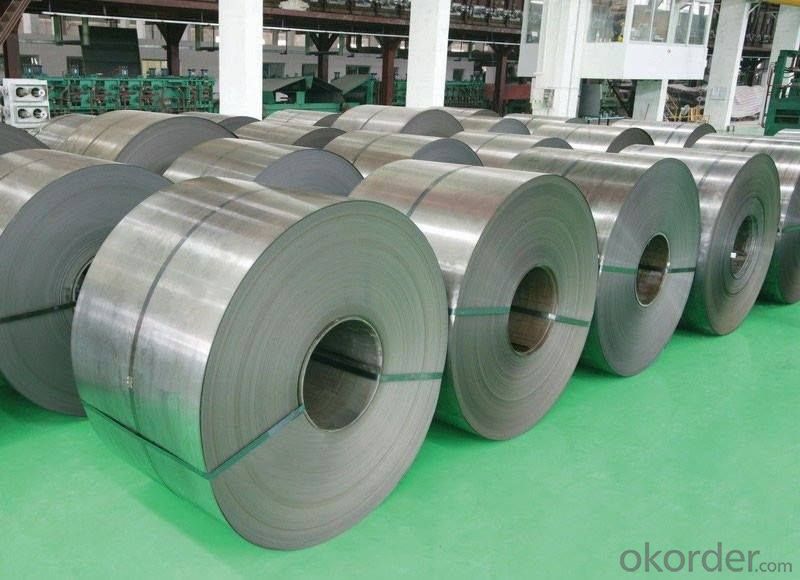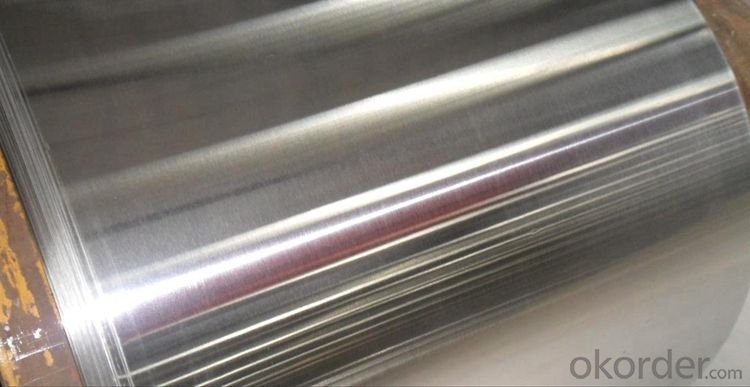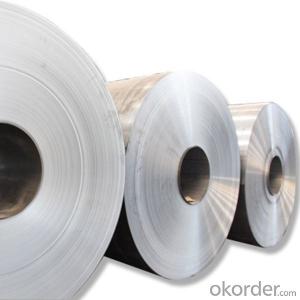Stainless Steel Coils 200 Series From China With High Quality
- Loading Port:
- Shanghai
- Payment Terms:
- TT OR LC
- Min Order Qty:
- 25 m.t.
- Supply Capability:
- 20000 m.t./month
OKorder Service Pledge
OKorder Financial Service
You Might Also Like
Item specifice
Products Description for Stainless Steel Coils/Sheets:
Item | cold rolled 201 stainless steel coil |
Technical | Hot rolled and cold rolled |
Standard | ASTM A240,GB/T3280-2007,JIS4304-2005,ASTM A167,EN10088-2-2005,GB/T3280-2007,EN10095-99,JIS4312,etc |
Material | 201,202,304,304L,309S,310S,316,316L,316Ti,430 |
Surface | NO.1,2b,4K,8k,HL,mirror finish |
Thickness | 0.3-100mm |
Width | 500-2000mm |
Price term | FOB,CFR,CIF |
Application | Stainless steel coil applies to construction field, ships building industry, petroleum, chemical industries, war and electricity industries, food processing and medical industry, boiler heat exchanger, machinery and hardware fields. Stainless steel coil can be made according to the customer’s requirements. |
Contact | If you have any question, please feel free to contact me. |
Specifications for Stainless Steel Coils/Sheets:
Grade | C ≤ | Si ≤ | Mn ≤ | P ≤ | S ≤ | Ni ≤ | Cr ≤ |
201 | 0.12 | 0.75 | 7.00 | 0.045 | 0.045 | 1.00-1.28 | 13.70-15.70 |
202 | 0.15 | 1.00 | 2.25 | 0.045 | 0.045 | 4.07-4.17 | 14.00-16.00 |
304 | 0.08 | 0.75 | 2.00 | 0.045 | 0.03 | 8.00-11.00 | 18.00-20.00 |
304L | 0.035 | 0.75 | 2.00 | 0.045 | 0.03 | 8.00-13.00 | 18.00-20.00 |
309 | 0.15 | 0.75 | 2.00 | 0.045 | 0.03 | 12.00-15.00 | 22.00-24.00 |
310S | 0.08 | 1.50 | 2.00 | 0.045 | 0.03 | 19.00-22.00 | 24.00-26.00 |
316 | 0.08 | 1.00 | 2.00 | 0.045 | 0.03 | 10.00-14.00 | 16.00-18.00 |
316L | 0.035 | 0.75 | 2.00 | 0.045 | 0.03 | 10.00-15.00 | 16.00-18.00 |
321 | 0.04-0.10 | 0.75 | 2.00 | 0.045 | 0.03 | 9.00-13.00 | 17.00-20.00 |
405 | 0.08 | 0.75 | 1.00 | 0.045 | 0.03 | 0.06 | 11.5-13.5 |
409 | 0.089 | 1.00 | 1.00 | 0.045 | 0.05 | 0.06 | 10.50-11.75 |
410 | 0.15 | 0.75 | 1.00 | 0.045 | 0.03 | 0.06 | 11.5-13.5 |
420 | 0.16-0.25 | 1.00 | 1.00 | 0.040 | 0.03 | 0.06 | 12.00-14.00 |
430 | 0.12 | 0.75 | 1.00 | 0.045 | 0.03 | 0.06 | 16.00-18.00 |
Packaging & Delivery for Stainless Steel Coils/Sheets:
Packaging Detail | Standard export packing or following customer's demand |
Delivery Time | Within 30-40 days after deposit or according to the order quantity |
Detail picture for Stainless Steel Coils/Sheets



FAQ for Stainless Steel Coils/Sheets:
Q:How to order?
A: Please send us your purchase order by email or fax .or you can ask us to send you a proforma invoice for your order .We need to know the following information for your order.
1) Shipping information-company name, street address, phone number, fax number, destination sea port
2) Product information – Quantity, Specification (steel type, thickness, width, surface finish)
3) Delivery time required
4) Forwarder's contact details if there's any in China
FAQ for Stainless Steel Coils/Sheets:
Q: How can I get the samples?
A: If you need some samples to test ,please pay for the transportation freight of samples and our samples are free for you.
Q: How can I get your price list?
A: Please send us your email or fax and order information – Quantity, Specification (steel type, thickness, width, surface finish), then I can send you the price list.
- Q:Can stainless steel sheets be used for fermentation tanks?
- Yes, stainless steel sheets can be used for fermentation tanks. Stainless steel is a preferred material for fermentation tanks due to its durability, corrosion resistance, and ability to maintain the desired temperature. It is non-reactive, which means it does not interact with the fermenting substances, ensuring the purity and quality of the product. Stainless steel is also easy to clean and sanitize, which is crucial for maintaining hygienic conditions during the fermentation process. Additionally, stainless steel sheets can be fabricated into various shapes and sizes to meet specific fermentation tank requirements. Overall, stainless steel sheets are a reliable and popular choice for fermentation tanks in various industries, including brewing, winemaking, and food processing.
- Q:Can stainless steel sheets be used in architectural applications?
- Yes, stainless steel sheets can be used in architectural applications. Stainless steel is a versatile material that offers durability, corrosion resistance, and aesthetic appeal, making it suitable for various architectural purposes such as cladding, roofing, decorative elements, and structural components. Its sleek, modern look and ability to withstand harsh environmental conditions make stainless steel sheets a popular choice in the construction industry.
- Q:How do you measure the thickness of stainless steel sheets?
- One common way to measure the thickness of stainless steel sheets is by using a tool called a caliper. This handheld device allows you to accurately measure the distance between two points on the sheet, providing an indication of its thickness. Additionally, there are specialized tools such as micrometers and ultrasonic thickness gauges that can also be used for more precise measurements in specific applications.
- Q:What are the benefits of using perforated stainless steel sheets?
- There are several benefits of using perforated stainless steel sheets in various applications. Firstly, perforated stainless steel sheets offer excellent strength and durability. Stainless steel is known for its high tensile strength and resistance to corrosion, making it a reliable choice for applications that require strong and long-lasting materials. The perforations in the sheets also do not compromise their structural integrity, ensuring that they can withstand heavy loads and harsh environments. Secondly, perforated stainless steel sheets provide excellent ventilation and airflow. The perforations allow air and other gases to pass through the sheets, making them ideal for applications that require proper ventilation, such as HVAC systems, industrial machinery, and automotive components. This ventilation capability helps prevent the buildup of heat and moisture, which can be crucial in maintaining the efficiency and safety of various equipment. Additionally, perforated stainless steel sheets offer versatility in design and aesthetics. The ability to customize the size, shape, and pattern of the perforations allows for the creation of unique and visually appealing designs. This makes them suitable for architectural applications, interior design elements, and decorative purposes. The wide range of available perforation patterns also enables the control of light transmission, creating interesting lighting effects or privacy screens. Moreover, perforated stainless steel sheets have excellent filtration capabilities. The perforations can be designed to filter out specific particles or substances, making them ideal for applications in the food and beverage industry, pharmaceuticals, and water treatment systems. This feature ensures the cleanliness and purity of the materials or fluids passing through the sheets, improving overall product quality and safety. Lastly, perforated stainless steel sheets are easy to clean and maintain. Stainless steel is non-porous, making it resistant to stains, dirt, and bacteria. This property, combined with the perforations, allows for easy cleaning and disinfection, making them suitable for applications that require high levels of hygiene, such as commercial kitchens, medical facilities, and laboratories. In summary, the benefits of using perforated stainless steel sheets include their strength and durability, ventilation capabilities, versatility in design, filtration capabilities, and ease of cleaning and maintenance. These qualities make them a preferred choice in a wide range of industries and applications.
- Q:What are the different types of stainless steel sheet thicknesses available?
- There is a wide variety of stainless steel sheet thicknesses to choose from, each serving different purposes and applications. The most commonly used thicknesses range from 0.4mm to 3.0mm, with increments of 0.4mm. These sheets are typically utilized in general applications such as construction, automotive parts, and household appliances. For more specialized applications, one can find thinner stainless steel sheets with thicknesses ranging from 0.1mm to 0.3mm. These thinner sheets are commonly employed in industries like electronics, telecommunications, and medical equipment manufacturing, where precise and delicate components are necessary. On the other hand, thicker stainless steel sheets, starting from 3.0mm and going up to 20mm or more, are reserved for heavy-duty applications like industrial machinery, shipbuilding, and construction projects that require exceptional structural integrity and durability. It's important to keep in mind that the available stainless steel sheet thicknesses may vary depending on the manufacturer and the intended use. Moreover, custom thicknesses can be manufactured to meet the specific requirements of a project.
- Q:How do you drill holes in stainless steel sheets?
- Drilling holes in stainless steel sheets requires some specific steps and tools to ensure accurate and clean results. Here's a step-by-step guide on how to drill holes in stainless steel sheets: 1. Gather the necessary tools: You will need a drill machine, suitable drill bits for stainless steel (preferably cobalt or carbide), center punch, safety goggles, work gloves, and a clamp or vise to secure the stainless steel sheet. 2. Choose the right drill bit: Stainless steel is a tough material, so regular drill bits may not be effective. Cobalt or carbide drill bits are more appropriate for stainless steel as they are specifically designed to cut through hard metals. 3. Mark the hole position: Use a center punch to create a small indentation at the exact spot where you want to drill the hole. This will prevent the drill bit from slipping while starting the hole. 4. Secure the stainless steel sheet: Clamp or secure the stainless steel sheet firmly to a workbench or surface to avoid movement during drilling. This will ensure accurate and clean holes. 5. Wear safety gear: Put on safety goggles and work gloves to protect your eyes and hands from metal debris and sharp edges. 6. Start drilling: Place the drill bit on the marked indentation and apply light pressure to start the hole. Use a slower speed setting on your drill machine to prevent overheating. Gradually increase the pressure as you continue drilling. 7. Use cutting fluid or lubricant: To reduce friction and heat buildup, apply a cutting fluid or lubricant on the drill bit while drilling. This will help prolong the life of the drill bit and prevent the stainless steel sheet from discoloration or warping due to excessive heat. 8. Monitor the drilling progress: Keep an eye on the drilling progress and adjust the speed and pressure accordingly. It's essential to maintain a steady pace and avoid applying excessive force, as it can lead to drill bit breakage or damage to the stainless steel sheet. 9. Remove metal debris: Periodically stop drilling and remove metal debris from the hole to prevent clogging and ensure a clean hole. 10. Finish the hole: Once the desired hole size is achieved, slowly withdraw the drill bit from the stainless steel sheet. Smooth out any rough edges around the hole using a file or deburring tool. By following these steps and using appropriate tools, you can successfully drill holes in stainless steel sheets with precision and efficiency. Remember to take your time, prioritize safety, and maintain proper tool maintenance for optimal results.
- Q:Can stainless steel sheets be used for water treatment equipment?
- Yes, stainless steel sheets can be used for water treatment equipment. Stainless steel is highly resistant to corrosion and oxidation, making it an ideal material for water treatment applications. It is commonly used for tanks, pipes, valves, and other components in water treatment systems. Stainless steel's durability and hygienic properties make it suitable for handling various types of water, including drinking water, wastewater, and industrial process water. Additionally, stainless steel is easy to clean and maintain, ensuring the longevity and efficiency of water treatment equipment.
- Q:What are the different types of stainless steel sheet surface finishes available?
- Some of the different types of stainless steel sheet surface finishes available include: 1. No.1 Finish: This is a rough, dull surface finish with visible grain lines. 2. No.2B Finish: It has a smooth, bright finish that is commonly used for appliances and architectural applications. 3. No.4 Finish: This finish has a brushed appearance with fine grain lines and is often used in decorative applications. 4. No.8 Mirror Finish: It provides a highly reflective surface that is used for decorative purposes. 5. Satin Finish: It has a smooth, silky appearance with low reflectivity and is commonly used in architectural and decorative applications. 6. Brushed Finish: This finish has a consistent linear grain pattern created by brushing the surface with abrasive materials. 7. Embossed Finish: It features raised patterns or textures on the surface, providing a decorative and tactile effect. 8. Bead Blast Finish: It creates a uniform, matte surface texture by blasting stainless steel sheets with fine glass beads. 9. Etched Finish: This finish involves chemically etching the surface to create patterns or designs. 10. Colored Finish: Stainless steel sheets can be coated or treated to achieve various colors and finishes, allowing for customization and aesthetic appeal.
- Q:Can stainless steel sheets be used for elevator ceilings?
- Yes, stainless steel sheets can be used for elevator ceilings. Stainless steel is a popular choice for elevator ceilings due to its durability, sleek appearance, and resistance to corrosion. It is a versatile material that can be easily formed into different shapes and sizes to fit various elevator designs. Stainless steel sheets also offer excellent fire resistance and can withstand high temperatures, making them a safe choice for elevator ceilings. Additionally, stainless steel is easy to clean and maintain, ensuring that elevator ceilings maintain their attractive appearance over time.
- Q:What are the different types of etched patterns available for stainless steel sheets?
- There are various types of etched patterns available for stainless steel sheets, including geometric designs, floral motifs, abstract patterns, textured surfaces, and custom designs.
1. Manufacturer Overview |
|
|---|---|
| Location | |
| Year Established | |
| Annual Output Value | |
| Main Markets | |
| Company Certifications | |
2. Manufacturer Certificates |
|
|---|---|
| a) Certification Name | |
| Range | |
| Reference | |
| Validity Period | |
3. Manufacturer Capability |
|
|---|---|
| a)Trade Capacity | |
| Nearest Port | |
| Export Percentage | |
| No.of Employees in Trade Department | |
| Language Spoken: | |
| b)Factory Information | |
| Factory Size: | |
| No. of Production Lines | |
| Contract Manufacturing | |
| Product Price Range | |
Send your message to us
Stainless Steel Coils 200 Series From China With High Quality
- Loading Port:
- Shanghai
- Payment Terms:
- TT OR LC
- Min Order Qty:
- 25 m.t.
- Supply Capability:
- 20000 m.t./month
OKorder Service Pledge
OKorder Financial Service
Similar products
New products
Hot products
Related keywords

































